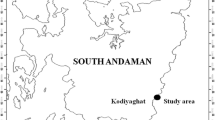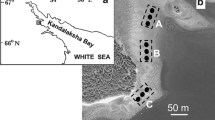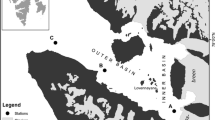Abstract
The composition and abundance of bladedwelling meiofauna was determined over a 15 mo period (1983–1984) from a Thalassia testudinum Banks ex König meadow near Egmont Key, Florida, USA. Harpacticoid copepods, copepod nauplii, and nematodes were the most abundant meiofaunal taxa on T. testudinum blades. Temporal patterns in species composition and population life-history stages were determined for harpacticoid copepods, the numerically predominant taxon. Sixteen species or species complexes of harpacticoid copepods were identified. Harpacticus sp., the most abundant harpacticoid, comprised 47.8% of the total copepods collected, and was present throughout the study. Copepodites dominated the population structures of the blade-dwelling harpacticoid species on most collection dates. Ovigerous females and/or copepodites were always present, indicating continuous reproductive activity. Results suggest that epiphytic algae influence meiofaunal abundance on seagrass blades, as densities of most meiofaunal taxa at Egmont Key were positively associated with percent cover of epiphytic algae throughout the study. The majority of significant correlations between meiofaunal density and cover of epiphytic algae involved filamentous algae, although encrusting algae dominated the epiphytic community. It appears that resources provided by epiphytic algae to seagrass meiofauna (additional food, habitat, and/or shelter from predation) may be associated with algal morphology.
Similar content being viewed by others
Literature cited
Bell, S. S., Walters, K., Kern, J. C. (1984). Meiofauna from seagrass habitats: a review and prospectus for future research. Estuaries 7:331–338
Chapman, G. (1955). Aspects of the fauna and flora of the Azores. 6. The density of animal life in the coralline alga zone. Ann. Mag. nat. Hist. 95: 801–805
Colman, J. (1940). On the faunas inhabiting intertidal seaweeds. J. mar. biol. Ass. U.K. 24: 129–183
Coull, B. C. (1970). Shallow water meiobenthos of the Bermuda platform. Oecologia 4: 325–357
Coull, B. C., Creed, E. L., Eskin, R. A., Montagna, P. A., Palmer, M. A., Wells, J. B. J. (1983). Phytal meiofauna from the rocky intertidal at Murrells Inlet, South Carolina. Trans. Am. microsc. Soc. 102: 380–389
Coull, B. C., Dudley, B. W. (1985). Dynamics of meiobenthic copepod populations: a long-term study (1973–1983). Mar. Ecol. Prog. Ser. 24: 219–229
Coull, B. C., Fleeger, J. W. (1977). Long-term temporal variation and community dynamics of meiobenthic copepods. Ecology 58: 1136–1143
D'Amours, D. (1988). Temperature beat on a tidal flat: potential cue for harpacticoid bloom. Neth. J. Sea Res. 22: 301–305
Edgar, G. J. (1983). The ecology of south-east Tasmanian phytal animal communities. II. Seasonal change in plant and animal populations. J. exp. mar. Biol. Ecol. 70: 159–179
Fleeger, J. W. (1980). Community structure of an estuarine meiobenthic copepod assemblage. Estuar. cstl mar. Sci. 10: 107–118
Fleeger, J. W. (1985). Meiofaunal densities and copepod species composition in a Louisiana, U.S.A., estuary. Trans. Am. microsc. Soc. 104: 321–332
Fraser, J. H. (1936). The distribution of rock pool Copepoda according to tidal level. J. Anim. Ecol. 5: 23–28
Gee, J. M. (1987). Impact of epibenthic predation on estuarine intertidal harpacticoid copepod populations. Mar. Biol 96: 497–510
Gunnill, F. C. (1982). Effects of plant size and distribution on the numbers of invertebrate species and individuals inhabiting the brown alga Pelvetia fastigiata. Mar. Biol. 69: 263–280
Hagerman, L. (1966). The macro- and microfauna associated with Fucus serratus L., with some ecological remarks. Ophelia 3: 1–43
Hall, M. O. (1988). Dynamics and interactions of epiphytic macroalgae and meiofauna on the seagrass Thalassia testudinum. Ph. D. dissertation. University of South Florida, Tampa
Hall, M. O., Bell, S. S. (1988). Response of small motile epifauna to complexity of epiphytic algae on seagrass blades. J. mar. Res. 46: 613–630
Harlin, N. M. (1980). Seagrass epiphytes. In: Phillips, R. C., McRoy, C. P. (eds.) Handbook of seagrass biology: an ecosystem perspective. Garland STPM Press, New York, p. 117–151
Hicks, G. R. F. (1977a). Species composition and zoogeography of marine phytal harpacticoid copepods from Cook Strait, and their contribution to total phytal meiofauna. N. Z. Jl mar. Freshwat. Res. 11: 441–469
Hicks, G. R. F. (1977b). Species associations and seasonal population densities of marine phytal harpacticoid copepods from Cook Strait. N. Z. Jl mar. Freshwat. Res. 11: 621–643
Hicks, G. R. F. (1977c). Breeding activity of marine phytal harpacticoid copepods from Cook Strait. N. Z. Jl mar. Freshwat. Res. 11: 645–666
Hicks, G. R. F. (1979). Pattern and strategy in the reproductive cycles of benthic harpacticoid copepods. In: Naylor, E., Hartnoll, R. G. (eds.). Cyclic phenomena in marine plants and animals. Pergamon Press, Oxford, p. 139–141 (Proc. 13th Eur. mar. Biol. Symp.)
Hicks, G. R. F. (1980). Structure of phytal harpacticoid copepod assemblages and the influence of habitat complexity and turbidity. J. exp. mar. Biol. Ecol 44: 157–192
Hicks, G. R. F. (1985). Meiofauna associated with rocky shore algae. In: Moore, P. G., Seed, R. (eds.). The ecology of rocky coasts. Hoddr & Stoughton, London, p. 36–56
Hicks, G. R. F. (1986). Distribution and behaviour of meiofaunal copepods inside and outside seagrass beds. Mar. Ecol. Prog. Ser. 31: 159–170
Hicks, G. R. F., Coull, B. C. (1983). The ecology of marine meiobenthic harpacticoid copepods. Oceanogr. mar. Biol. A. Rev. 21: 67–175
Hopper, B. E., Meyers, S. P. (1967). Folicolous marine nematodes on turtle grass Thalassia testudinum König, in Biscayne Bay, Florida. Bull. mar. Sci. 17: 471–517
Humm, H. J. (1964). Epiphytes of the seagrass, Thalassia testudinum, in Florida. Bull. mar. Sci. Gulf Caribb. 14: 306–341
Johnson, S. C., Scheibling, R. E. (1987a). Structure and dynamics of epifaunal assemblages on intertidal macroalgae Ascophyllum nodosum and Fucus vesiculosus in Nova Scotia, Canada. Mar. Ecol. Prog. Ser. 37: 209–227
Johnson, S. C., Scheibling, R. E. (1987b). Reproductive patterns of harpacticoid copepods on intertidal macroalgae (Ascophyllum nodosum and Fucus vesiculosus) in Nova Scotia, Canada. Can. J. Zool. 65: 129–141
Kangas, P. (1978). On the quantity of meiofauna among the epiphytes of Fucus vesiculosus in the Askö area, northern Baltic Sea. Contr. Askö Lab., Univ. Stockholm 24: 1–32
Kikuchi, T. (1980). Faunal relationships in temperate seagrass beds. In: Phillips, R. C., McRoy, C. P. (eds.) Handbook of seagrass biology: an ecosystem perspective. Garland STPM Press, New York, p. 153–172
Kito, K. (1975). Preliminary report on the phytal animals in the Sargassum confusum region in Oshoro Bay, Hokkaido. J. Fac. Sci. Hokkaido Univ. (Ser. 6: Zool.) 20: 141–158
Kito, K. (1977). Phytal animals in the Sargassum confusum region in Oshoro Bay, Hokkaido: phenology of harpacticoid copepods. J. Fac. Sci. Hokkaido Univ. (Ser. 6: Zool.) 20: 691–696
Kito, K. (1982). Phytal marine nematode assemblage on Sargassum confusum Agardh, with reference to the structure and seasonal fluctuations. J. Fac. Sci. Hokkaido Univ. (Ser. 6: Zool.) 23: 143–161
Knatz, G. (1986). Temporal distribution and reproductive patterns of harpacticoid copepods from Los Angeles-Long Beach Harbors. J. Crustacean Biol. 6: 79–88
Leber, K. (1983). Feeding ecology of decapod crustaceans and the influence of vegetation on foraging success in a sub-tropical seagrass meadow. Ph. D. dissertation. Florida State University, Tallahassee
Lewis, J. B., Hollingworth, C. E. (1982). Leaf epifauna of the seagrass Thalassia testudinum. Mar. Biol. 71: 41–49
Meyer, H. A. (1990). Ecology of the harpacticoid Metis holothuriae: patterns of population structure, detrital relationships and synchronization of recruitment. Ph. D. dissertation. University of S. Florida, Tampa
Meyer, H. A., Bell, S. S. (1989). Response of harpacticoid copepods to detrital accumulation on seagrass blades: a field experiment with Metis holothuriae (Edwards). J. exp. mar. Biol. Ecol. 132: 141–149
Nagle, J. S. (1968). Distribution of the epibiota of macroepibenthic plants. Contr. mar. Sci. Univ. Tex. 13: 105–144
Noodt, W. (1957). Zur Okologie der Harpacticoidea (Crust. Cop.) des Eulitorals der Deutschen Meeresküste und der angrenzenden Brackgewässer. Z. Morph. Ökol. Tiere. 46: 149–242
Novak, R. (1982). Spatial and seasonal distribution of the meiofauna in the seagrass Posidonia oceanica. Neth. J. Sea Res. 16: 380–388
Ohm, G. (1964). Die Besiedlung der Fucus-Zone der Kieler Bucht und der westlichen Ostsee unter besonderer Berücksichtigung der Mikrofauna. Kieler Meeresforsch. 1: 1–48
Orth, R. J., Van Montfrans, J. (1984). Epiphyte-seagrass relationships with an emphasis on the role of micrograzing: a review. Aquat. Bot. 18: 43–69
Pallares, R. E., Hall, M. A. (1974a). Analisis bioestadistico-ecologico de la fauna de copepodos asociados a los bosques de Macrocystis pyrifera. Physis, B. Aires 33: 275–319
Pallares, R. E., Hall, M. A. (1974b). Analisis bioestadistico-ecologico de la fauna de copepodos asociados a los bosques de Macrocystis pyrifera (Conclusion). Physis, B. Aires 33: 409–432
Palmer, M. A., Gust, G. (1985). Dispersal of meiofauna in a turbulent tidal creek. J. mar. Res. 43: 179–210
Sherman, K. M., Meeter, D. A., Reidenauer, J. A. (1984). A technique for subsampling an abundant taxon while completely sorting other taxa. Limnol. Oceanogr. 29: 433–439
Sogard, S. M. (1984). Utilization of meiofauna as a food source by a grassbed fish, the spotted dragonet Callionymus pauciradiatus. Mar. Ecol. Prog. Ser. 17: 183–191
Thorson, G. (1957). Bottom communities (sublittoral or shallow shelf). Mem. geol. Soc. Am. 67: 461–534
Tipton, K., Bell, S. S. (1988). Foraging patterns of two sygnathid fishes: importance of harpacticoid copepods. Mar. Ecol. Prog. Ser. 47: 31–43
Tito de Morais, L., Bodiou, J. Y. (1984). Predation on meiofauna by juvenile fish in a Western Mediterranean flatfish nursery ground. Mar. Biol. 82: 209–215
Walters, K. (1987). Experimental investigations of vertically migrating meiofaunal populations in subtropical sand and seagrass habitats. Ph. D. dissertation. University of S. Florida, Tampa
Walters, K., Bell, S. S. (1986). Diel patterns of active vertical migration in seagrass meiofauna. Mar. Ecol. Prog. Ser. 34: 95–103
Wieser, W. (1952). Investigations on the microfauna inhabiting seaweeds on rocky coasts. IV. Studies on the vertical distribution of the fauna inhabiting seaweeds below the Plymouth laboratory. J. mar. biol. Ass. U.K. 31: 145–174
Wieser, W. (1959). Zur Okologie der Fauna mariner Algen mit besonderer Berücksichtigung des Mittelmeeres. Int. Revue ges. Hydrobiol 44: 137–180
Zavodnik, D. (1967). The community of Fucus virsoides (Don.) J. Ag. on a rocky shore near Rovinji (Northern Adriatic). Thalassia jugosl. 3: 105–113
Author information
Authors and Affiliations
Additional information
Communicated by J. M. Lawrence, Tampa
Rights and permissions
About this article
Cite this article
Hall, M.O., Bell, S.S. Meiofauna on the seagrass Thalassia testudinum: population characteristics of harpacticoid copepods and associations with algal epiphytes. Marine Biology 116, 137–146 (1993). https://doi.org/10.1007/BF00350741
Received:
Accepted:
Issue Date:
DOI: https://doi.org/10.1007/BF00350741




